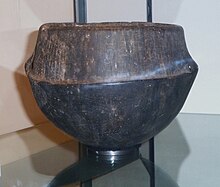Western Neolithic ware
The Western Neolithic Ware (also Western Style Neolithic pottery ) is an early and middle Neolithic pottery that was found in the western parts of the British Isles , particularly Ireland . It was defined by Humphrey Case in 1961 . He described the ceramic as a mostly round-bottomed bowl, which is usually smooth, thin-walled and hard, mostly dark brown and sometimes with a profile in the shoulder or mouth area.
Four subgroups have been identified in Ireland:
- Dunmurry style,
- Ballymarlagh style
- Limerick style I (round bottom)
- Limerick Style II (Flat)
- Lyles Hill style.
In the course of time, more decoration was added. Simple stitch patterns on the shoulder made with a piece of wood may represent a container made of leather.
Corded pots are so typical of Ireland that they came to be known as "Ballyalton Bowls," named after the court tomb where they were found. Similar pots have been found in graves in western Scotland . They are called Beacharra Ware there .
While smooth and ornate containers are typical of the Irish Court and Portal Tombs , they rarely appear on the associated settlement sites, but also on those of the builders of the Passage Tombs . However, they played the role of extraordinary pottery everywhere during the Neolithic period.
See also
literature
- L. Flanagan: Ancient Ireland Life before the Celts Dublin 1998 ISBN 0-7171-2433-9
Individual evidence
-
↑ Style of decorated middle Neolithic pottery found in western parts of Scotland and classified by Stuart Piggott into three groups:
- A = unornamented bag-shaped bowls;
- B = decorated carinated bowls with a rim diameter less than the diameter at the carination and incised or channeled ornament;
- C = small bowls with panel ornament in fine whipped cord.
